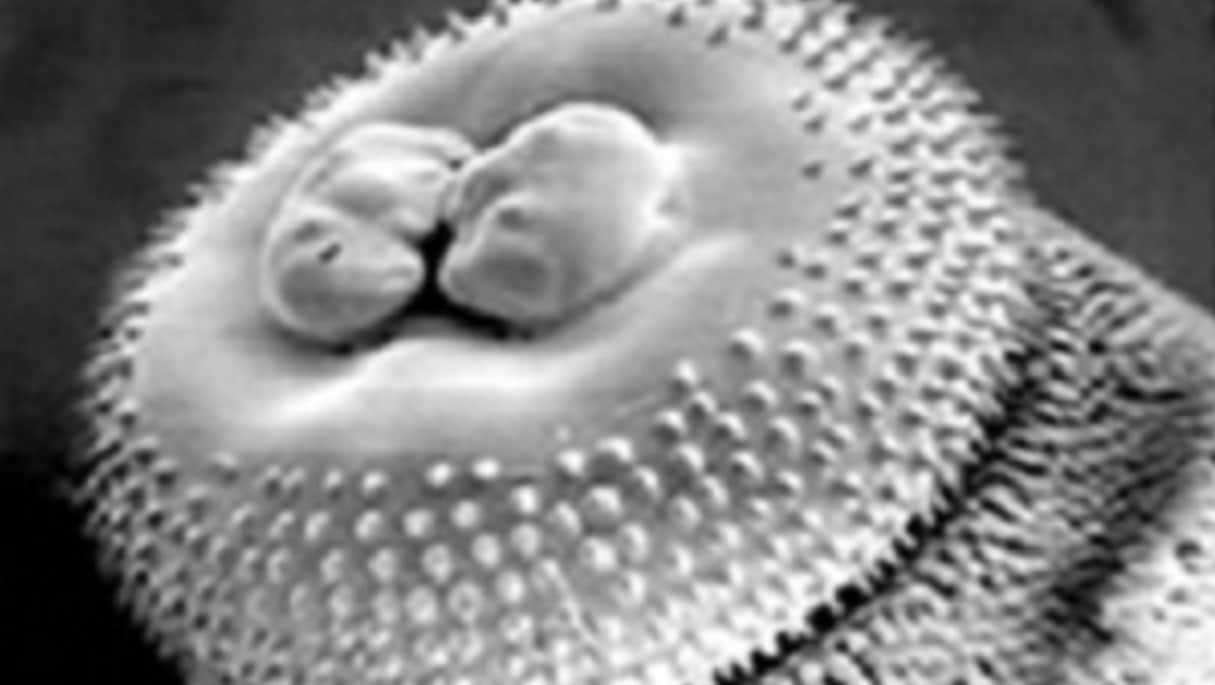Key points
- Human gnathostomiasis is a condition caused by several species of parasitic worms (nematodes).
- You can get infected by eating raw or undercooked freshwater fish, eels, frogs, birds, and reptiles.
- You can treat Gnathostoma infection with medication.

Overview
Gnathostoma spp. are a group of parasitic worms or nematodes. They pass through a series of animal hosts to complete their lifecycle.
Lifecycle
Depending on the species, adult Gnathostoma spp. can reproduce in dogs, cats, raccoons, opossums, tigers, leopards, pigs, wild boars, and weasels. These animals are called definitive hosts. The definitive host will release the parasites' eggs in their stool (poop) where they will hatch in freshwater. Copepods (also known as tiny "water fleas"), then eat the larvae in freshwater. In turn, animals such as freshwater fish, eels, frogs, birds, and reptiles eat the copepods. If definitive hosts eat one of these infected animals, they can become infected and the larvae can mature into the adult form and complete the life cycle.
If humans eat raw or undercooked meat from one of these infected animals, they too can become infected. However, the larvae of the parasite cannot mature the adult form.
Resource
Signs and symptoms
Experts think the symptoms of gnathostomiasis are related to the movement of the parasite through the body. When someone eats the parasite, it moves through the wall of the stomach or intestine and liver. During this early phase, many people have no symptoms. Or they may experience fever, excess tiredness, lack of appetite, nausea, vomiting, diarrhea, or abdominal pain. This phase may last for two or three weeks.
Later, when the parasite moves under the skin, people may experience swellings under the skin that may be painful, red, or itchy. The swellings move around and typically are not pitting. This means that if you push on the swelling with a finger, you will not see an indentation left behind. The swellings often begin within three to four weeks after ingestion of the parasite, but they can occur up to around 10 years after infection. The swellings typically last several weeks at a time. Rarely, Gnathostoma can enter other parts of the body, including the lungs, bladder, eyes, ears, and nervous system, including the brain.
Causes
You can get Gnathostoma infection by eating undercooked or raw infected freshwater fish. You can also become infected by eating raw or undercooked infected freshwater eels, frogs, birds, and reptiles.
People might also become infected by swallowing infected copepods or through exposure to the parasite while handling uncooked tissue from animals that are infected, though this is unproven.
You can find Gnathostoma spp. throughout the world. However, infections are most commonly diagnosed in Asia, particularly Thailand, other parts of Southeast Asia, and Japan. People have reported cases in other areas, including South and Central America and Africa.
Experts believe people do not get the parasite by eating sushi in the U.S. and Western Europe. This is because there are more stringent regulations in these areas on sourcing and storage of fish eaten by humans.
Prevention
The best way to not get gnathostomiasis is to not eat undercooked or raw freshwater fish, eels, frogs, birds, and reptiles. Marinating freshwater fish in lime juice, like when making ceviche, does not kill the parasite. Avoiding contaminated freshwater in areas where the parasite is commonly found, washing your hands with soap and warm water before and after preparing food, and wearing gloves when handling raw tissue from animals that might be infected may also reduce your risk of infection, though none of these has proven effective.
The FDA recommends the following for fish preparation or storage to kill parasites.
Cooking
- Cook fish adequately (to an internal temperature of at least 145° F [~63° C]).
Freezing (Fish)
- At -4°F (-20°C) or below for 7 days (total time), or
- At -31°F (-35°C) or below until solid, and storing at -31°F (-35°C) or below for 15 hours, or
- At -31°F (-35°C) or below until solid and storing at -4°F (-20°C) or below for 24 hours.
